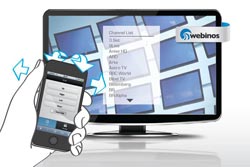Customized entertainment for web, smartphone & hybrid TV

Zapping through the television program by means of gestures using the mobile device, movements, or shaking. Copyright: Fraunhofer<br>
An entertainment program the viewer switches on in order to mentally unwind has gone the way of the dodo. At the IFA 2012 in Berlin from 31 August to 5 September in hall 11.1, booth 10, researchers from Fraunhofer FOKUS will exhibit how new entertainment technologies burst the limits of classic television.
Whether it's on televisions, mobile devices, or PCs – viewers will control the contents of movies and entertainment themselves, receive information on additional media, and actively participate in the program in the future, because television, communication technologies, and the internet are growing together. At the shared booth of the Fraunhofer corporation in the “Multiscreen Entertainment” area, the visitors of the IFA 2012 will receive an impression of the latest web technologies for interactive and cross-device entertainment on a total of four demo models.
Cross-device services
At the “Zap and Shake” exhibit, visitors can experience how to zap through the television program or their own media contents using a smartphone or tablet PC. The highlight: the system is operated simply by means of gestures using the mobile device, movements, or shaking. This new way of using device features in distributed services based on web technology is an example from the webinos project. Together with 23 international project partners such as Deutsche Telekom, Samsung and Sony, the Fraunhofer researchers are working on an open source platform allowing for the development of cross-platform and cross-domain apps.
“The exhibit demonstrates how to safely access media, data, and features on the basis of the webinos technology using differently networked devices, even today,” says Martin Lasak of Fraunhofer FOKUS. “The vision of the webinos project is to mutually make apps available on the devices of many manufacturers. Furthermore, the apps must be able to communicate safely within and between designated device groups – 'personal zones'.”
Interaction with TV and video
For those who find zapping through the program and browsing for the show they want too inconvenient, the Fraunhofer researchers have developed a practical service: the “TV Predictor”. Based on individual television viewing habits and explicit assessments, this app computes suitable program recommendations. At the IFA, visitors will have the chance to assess programs and will receive personalized predictions from the TV predictor regarding the current television program. The app is based on a software component developed by Fraunhofer FOKUS, an intelligent and scalable recommendation engine, and uses the standard HbbTV (Hybrid Broadcast Broadband TV) that can be used to display information from the internet on the television.
“tagging zone”: create your interactive video
The third exhibit also shows the combination of classic video and internet contents. Trade fair visitors can create interactive videos themselves and can share them with their friends on the internet. This is possible by means of the new Facebook app “veedlr”. veedlr is built on the basis of the “non-linear video” technology developed by Fraunhofer FOKUS. Using this technology, the user is able to tag videos themselves, to mark friends, and to create interactive buttons for exciting objects within the video. “Our technology makes creating and distributing interactive videos via social networks such as Facebook as easy as posting a message,” says Robert Seeliger from Fraunhofer FOKUS. “Of course, along with this community version, we also offer a comprehensive solution for professional customers.”
Browser-based DRM solution
Dynamic Adaptive Streaming over HTTP (MPEG DASH) is the new streaming standard for the internet and standardises video provision via the internet. Adaptive streaming is designed so that videos can be played efficiently and without interruptions in the best possible quality via the internet. Along with the implementation of a browser-based DASH client, Fraunhofer FOKUS will also present a DRM solution based on the ISO Base Media File Formats (ISO BMFF). By using a common encryption, different DRM systems are supported in one uniform file format, which simplifies the distribution and usage of protected contents.
Media Contact
More Information:
http://www.fokus.fraunhofer.de/go/ifaAll latest news from the category: Trade Fair News
Newest articles

Innovative 3D printed scaffolds offer new hope for bone healing
Researchers at the Institute for Bioengineering of Catalonia have developed novel 3D printed PLA-CaP scaffolds that promote blood vessel formation, ensuring better healing and regeneration of bone tissue. Bone is…

The surprising role of gut infection in Alzheimer’s disease
ASU- and Banner Alzheimer’s Institute-led study implicates link between a common virus and the disease, which travels from the gut to the brain and may be a target for antiviral…

Molecular gardening: New enzymes discovered for protein modification pruning
How deubiquitinases USP53 and USP54 cleave long polyubiquitin chains and how the former is linked to liver disease in children. Deubiquitinases (DUBs) are enzymes used by cells to trim protein…



